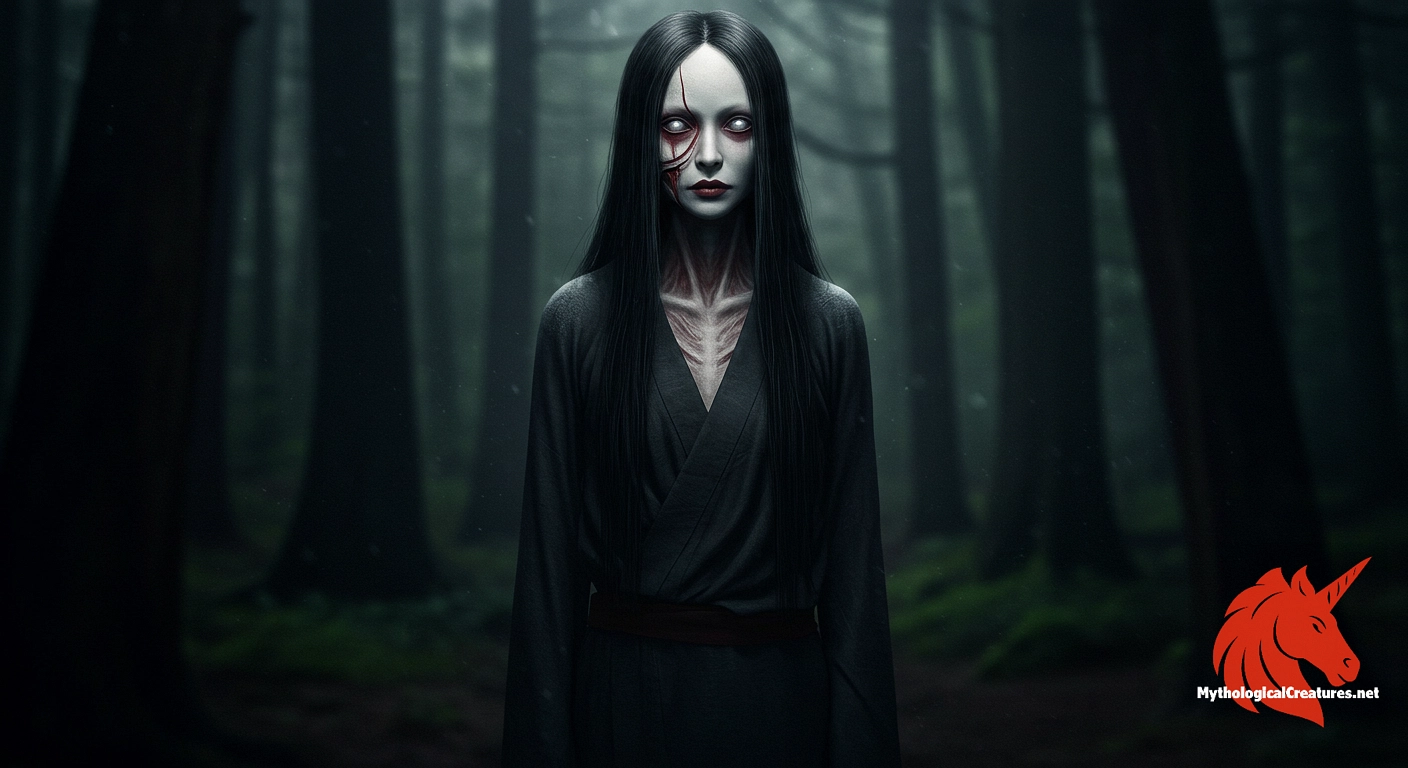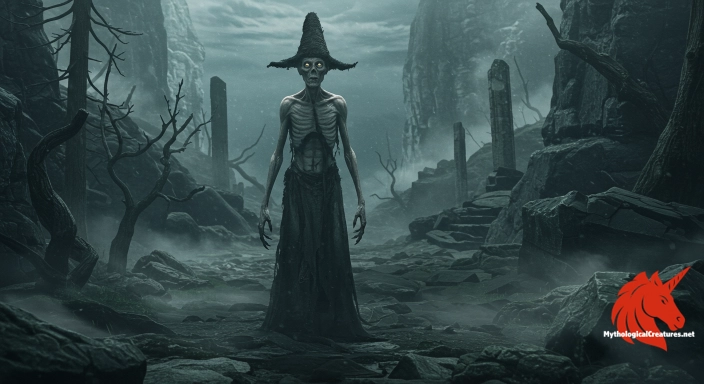Kuchisake-onna: Kuchisake-onna is a malevolent Japanese urban legend featuring a vengeful spirit with a gruesomely disfigured mouth.

Kuchisake-onna
Kuchisake-onna - Embodies societal fears and serves as a cautionary tale about vanity and the unpredictability of the supernatural.
Origins & First Encounters
Kuchisake-onna is a compelling figure rooted in the whispers of Japanese urban legend, where her tragic past and vengeful spirit have enraptured audiences for centuries. Born from the rich tradition of onryō, she embodies the duality of beauty and horror, a trait deeply embedded in Japan's cultural psyche. Her legend is often traced back to the Edo period, a time when supernatural tales helped to articulate the hidden fears and moral quandaries of society. The narrative surrounding her is adroitly layered with themes of vanity and retribution, as she confronts her victims with a disquieting question about their perception of her beauty. Many who recount her story are both captivated and repulsed by the unnerving fusion of aesthetic allure with mortal danger. Her existence highlights the prevalent moral caution within traditional folklore, where appearances can belie unfathomable truths. The myth has been continuously revitalised over time, growing from its origins in whispered local lore to a powerful modern parable. The enduring fascination with her spectral presence underscores the complex interplay between historical context and the timeless nature of myth.
Source Texts & Tale Variants
The earliest accounts of Kuchisake-onna can be traced to the timelines of the Edo period, where oral traditions captured her tale with both terror and mystique. Various narrative strands emerged, each embellishing her appearance and actions with regional nuances and dramatic flair. Traditional storytellers recounted her terrifying encounters as a moral lesson interwoven with everyday life, ensuring her legend was passed along by word of mouth. Later, during the tumultuous social changes of the 1970s, her story experienced a dramatic resurgence as newspapers and magazines brought renewed attention to this eerie figure. The print media of that era offered detailed, though sometimes conflicting, versions of her modus operandi and her chilling dialogue with potential victims. As these urban legends permeated schoolyards and neighbourhood conversations, the myth took on a life of its own, expanding well beyond its original folkloric boundaries. Each variant offers subtle differences in the details—from the type of weapon she wields to the specific circumstances of her encounters—making her story a patchwork of evolving societal fears. The multiplicity of sources and story variants has rendered her legend both diverse and dynamic, allowing it to persist in the public imagination.
Form & Powers
Visually, Kuchisake-onna presents a stark and unforgettable contrast between beauty and brutality. Traditionally depicted as a tall, statuesque woman, she is said to stand approximately 175-180 cm high, though certain accounts suggest a height reaching nearly eight feet. Her long, straight black hair cascades around a face that once may have been considered exquisite, now marred by a grotesque slit stretching from ear to ear. This horrifying disfigurement disrupts her otherwise elegant features, accentuating the haunting quality of her visage. Her skin, described as pallid and almost translucent, adds to the spectral aura that surrounds her. Even her hands are noted for their ghostly whiteness, contributing to an appearance both ethereal and unnerving. Often, part of her face is obscured by a mask or cloth, intensifying the mystery of her true identity. The deadly implement she carries—whether a pair of elongated scissors or a sharp knife—further accentuates the juxtaposition of appealing beauty with visceral violence. Each detail of her physical description reinforces the legacy of horror that has made her an enduring icon in myth.
Regional Faces
The narrative of Kuchisake-onna exhibits fascinating regional nuances that underscore the adaptability of her legend. In rural locales, the legend is often told amidst a backdrop of fog-laden paths and isolated villages, where the ghostly encounters are interwoven with local superstitions and the whisper of ancient rites. Urban adaptations, by contrast, tend to cast her as an ominous presence in modern cityscapes, where anonymous crowds and dim alleyways add a contemporary edge to her timeless terror. Certain regions embellish the tale with a note of tragedy, portraying her as a wronged spirit whose vengeful nature is tied to societal injustice. The weapon she wields and even details of her attire may vary subtly from one area to another, reflecting local moral and aesthetic sensibilities. These differences allow her narrative to serve as a reflection of communal fears—whether those stem from rural isolation or urban disquiet. Community-specific retellings highlight how folklore evolves in tandem with shifting cultural values and concerns. Through such regional reinterpretations, her spirit becomes not only a symbol of historical retribution but also a mirror of local identity and collective memory.
Cultural Parallels
In the rich tapestry of global folklore, Kuchisake-onna finds intriguing parallels with other vengeful female apparitions seen across diverse cultures. Similar to the onryō of Japan, figures like La Llorona in Latin American legend share a narrative steeped in tragedy and retribution, challenging cultural norms concerning beauty, family, and moral accountability. This spectral archetype, marked by a tragic past and an insistence on unsettling dialogue, reappears in different guises throughout Eastern and Western stories, each echoing the universal fear of betrayal and the perils of superficial charm. Her dramatic physical disfigurement resonates with other ghostly images, such as the 'White Lady' legends of Europe, where beauty is tainted by sorrow and vengeance. The dialogue she presents—posing questions that force personal reflection—serves as a metaphor for the harsh judgments cast by society across multiple traditions. Such comparative studies underscore how the interplay between aesthetic allure and repulsive horror can be a shared canvas for exploring deeper human anxieties. Her myth thus acts as a cultural bridge, linking distinct narrative traditions into a wider conversation on the consequences of beauty and the spectres of past grievances. Across these cultural intersections, her enduring presence continues to evoke discussions on gender, morality, and the social construction of beauty.
Legacy & Modern Evolution
The evolution of Kuchisake-onna’s tale vividly illustrates the enduring power of folklore to adapt and reflect societal changes. Originating in the Edo period, her story has been continually reshaped through centuries of oral and written narratives, evolving to capture the zeitgeist of each era. The reemergence of her legend in the 1970s, spurred by media coverage and heightened public imagination, marked a pivotal moment when traditional folklore intersected with modern urban reality. Contemporary portrayals in cinema, literature, and online media have transformed her into an icon of horror and a symbol of the complex interplay between beauty and malevolence. Modern reinterpretations often delve into her psychological dimensions, exploring themes such as identity, trauma, and the cost of societal expectations. Her shifting image mirrors broader cultural dialogues about the role of women in society and the legacy of historical injustice. As new forms of media continue to reshape storytelling, the myth of Kuchisake-onna remains a potent reminder of how age-old legends can remain relevant in a rapidly changing world. The horror she inspires transcends mere fright, serving as a cultural allegory for the sometimes treacherous nature of admiration and the unforeseen consequences of beauty.
Interesting Fact
An intriguing facet of the Kuchisake-onna legend is that survival often hinges on a victim's ability to outwit her by describing her appearance as 'average,' thereby subverting her malevolent expectations.
Quick Creature Info
Features:
Our Mythic Legendary Rating:

Also Sometimes Known As:
Habitat:
Supernatural Powers:
Physical Attributes:
Abilities:
Behavior:
Weaknesses:
Lore:
References
Discover Another Mythical Legend You May Not Have Heard Of?
Uncover the mysteries of ancient folklore and expand your knowledge of legendary beings from cultures around the world.
Dare to Meet the Tuoni....
Curated by the Mythological Creatures Team (rev. May 2025)
